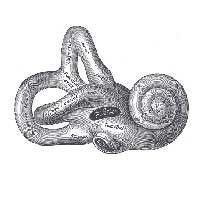Large Vestibular Aqueduct Syndrome

A recent discovery and diagnosis, large vestibular aqueduct syndrome is a term given when certain parts of the anatomy of the ear become enlarged. As it is such a new diagnosis, there is a lot of research and explorations being carried out by experts in order to fully understand this condition.
What Exactly Is It?
Connecting the inner ear to the cranial cavity (an area within the base of the skull) is a canal called the vestibular aqueduct. Running through this channel is a fluid filled tube, or duct, that continues on to a collection sac. In the instance of large vestibular aqueduct syndrome, the structures of the tube and sac become enlarged. If this occurs, there is potential for the fluid contained in the tube to flow back into the hearing structures causing problems.Why Does It Occur?
As research continues, experts now believe this condition develops in early childhood as the structures involved continue to develop and grow until around 4 years of age, leaving them more vulnerable to damage.It is thought that a head injury, sudden changes in atmospheric pressures or as a result of fluctuations in the pressure of cerebrospinal fluid, such as during exertion, may cause the condition to cause deafness or hearing loss.As research is still in its infancy, experts are still unsure of its exact cause though they are exploring the possibility of a chromosomal cause.Unfortunately, it can only be diagnosed using a CT (computerised tomography) scan of the base of the skull, something that is very costly and not readily available as a general diagnostic tool. During this scan, the enlargement can be seen and measured against the normal size of these structures.
Symptoms of Large Vestibular Aqueduct Syndrome
As a type of sensorineural hearing loss, the most obvious symptom is hearing loss. The degree of hearing loss experienced varies from person to person, and unfortunately total deafness is common.Treatment Options
Unless total deafness is experienced, hearing aids can provide some relief for sufferers, though regular hearing tests to check for deterioration will be required.Up to now, there are no indications for surgery to try and reduce the enlargement of the structures, but as experts carry on learning about this condition, there may be potential to develop this idea in the future.Until research can provide more answers to this condition, education and participation in research projects are likely to be suggested to help find out more about this condition.As this condition is not fully understood and is so new in being discovered, there are some audiologists who are not fully aware of its presence or symptoms, so collecting data regarding prevalence, diagnosis etc are difficult to obtain and true figures are still unknown, though it is so far thought to be relatively uncommon.
Large vestibular aqueduct syndrome is a relatively new condition that continues to be researched in order to help experts understand, diagnose and treat. Research will continue until understanding is gained, and, thanks to modern scanning technologies, this disorder can now be explored more fully.
- Psoriasis and the Ear
- Common Vestibular Disorders
- Dizziness: Is it Caused by a Virus?
- Cysts and Tumours in the Ear
- Pressure Sores and the Ears
- Head Trauma and the Ear
- Allergies and Ear Health
- What is Glue Ear?
- Usher's Syndrome: Deterioration of Sight and Hearing
- The Effects of Over Exposure to Water: Surfer's Ear
- Acoustic Neuroma: Benign Tumour from Auditory Nerve
- Cauliflower Ears
- Sensorineural Deafness and Noise Damage
- Autoimmune Inner Ear Disease
- Cholesteatoma
- Perforated Eardrum
- Otitis Media and Infection of the Middle Ear
- Barotrauma
- Vertigo and the Inner Ear
- Mastoiditis
- Swimmer's Ear
- Labyrinthitis
- Objects In The Ear
- Ear Canal Blockage
- Tinnitus and Treatments Available
- Meniere's Disease and the Inner Ear
- Ear Infection


Re: Types of Ear Surgery
My child is born with deaf. So what should i do. Which treatment should i take to my child
Re: How Your Genes Shape Your Ear Lobes
My 2 month old has one free earlobe and his other ear has a half attached earlobe why? Should I be concerned?
Re: I Feel Dizzy and My Ear Itches: What Does it Mean?
I have noticed my ears are producing more sticky staff, itching and in the middle of last year I…
Re: Can Ear Wax Be Removed by Vacuum?
Vacuuming caused a 30% hearing loss. Don't allow it. Find a dr or audiologist who avoids it.
Re: Cysts and Tumours in the Ear
I had a pollock in my ear. can they regrow ?
Re: Grommets and Your Ear
@Ella - I'm afraid we can't give direct medical advice. The best option you have is to visit your GP and hope he/she will be able to help…
Re: Grommets and Your Ear
I had grommets when I was 2 and 5, a few weeks ago I found out I have scarring and 1 of my grommets are still in my ear meaning I had it in…
Re: Can Ear Wax Be Removed by Vacuum?
I had an ear wax removal procedure done at the Loma Linda, Ca Va facility. When the tech was vacuuming out the wax in my…
Re: Cysts and Tumours in the Ear
@CarrolA - I have no knowledge of your condition or what it might be. But if you want a quicker appointment, and peace of mind,…
Re: Cysts and Tumours in the Ear
I woke up one morning about five weeks ago with a feeling that my ear was blocked. A strange additional symptom is that every word…